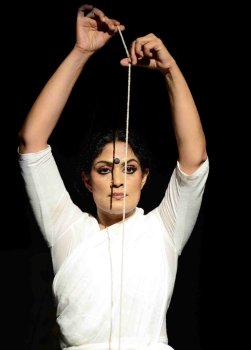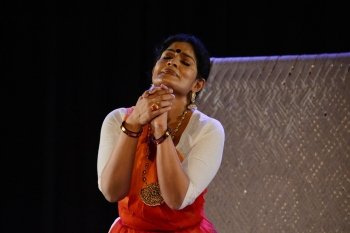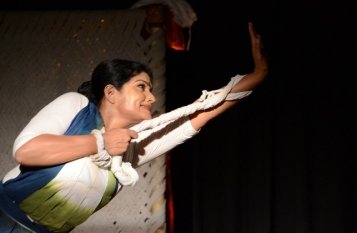
|   |

|   |
Gandhi: Warp and Weft - Epic action in flowing sketches - Dr. S. D. Desai e-mail: sureshmrudula@yahoo.co.in February 18, 2014 It is artistic economy and symbolic profusion that set Geeta Chandran’s Gandhi: Warp and Weft apart as one of the most significant enunciations of the essence of Gandhism and encapsulates the epic narrative of the greatest man after the Buddha that walked on this earth. With her controlled idiom drawing elements from Bharatanatyam and contemporary dance styles, in the process, develops metaphors out of the chief signifiers of his principal tenets having universal application.  Gandhi never claimed originality of his ideas. As old as the mountains, he would say, they are enshrined in our scriptures and have melted in our way of life. When individuals like Geeta Chandran portray them, they attain the look and feel of conviction. The dancer-choreographer’s originality is in putting them in a nutshell and across through a solo performance with consummate artistry - such that images both of Gandhi in epic action and of the performer almost in flowing beautiful sketches linger in memory. She picks up ideas underlying Gandhi’s actions, looking deceptively simple, and conveys them with suggestion, the hallmark of an artistic creation. Her takeoff on Gandhi appropriately is on spirituality: ‘Ram Ram jay Seeta Ram’, which flows into ‘Poorab Hari ka baas, pachhim Allaa ka mukaam’ with the same aharya on. She skips a familiar line like ‘Raghupati Raaghav...’, bringing in freshness, and in a few minutes bringing home to the viewers Gandhi’s all-embracing religious belief. The light, like a beacon, keeps glimmering through the netted charpoy. There comes a stage in the lives of saints and saintly beings when they renounce attachment to worldly belongings and bonds of relationship. Gandhi had a vision of god in the suffering masses of the country and he began to slough off what clung to him – adornments of clothing, sensory pleasures and all. The dancer signifies it with minimalist graceful action symbolic of high ascension. You need a bit of Gandhi in you to understand him – in writing, speech and action. A process of evolution, rare in the history of mankind, sets in now. The choreographer goes on to portray individual and collective bondage, the struggle to get free from it, violent resistance to the pursuit of freedom, non-violent inner force combating it, empathy turning into compassion for all, emancipation and empowerment of the lowly and the weak and metaphoric endeavours to conserve ecology. 

With lights designed by Deepa Dharmadhikari and costumes by Sandhya Raman in cotton and khadi making an integral contribution to the performance, Gandhi was presented at Darpana’s Festival of Nonviolence in Ahmedabad. Dr. SD Desai, a professor of English, has been a Performing Arts Critic for many years. Among the dance journals he has contributed to are Narthaki, Sruti, Nartanam and Attendance. He guest-edited Attendance 2013 Special Issue. His books have been published by Gujarat Sahitya Academy, Oxford University Press and Rupa. After 30 years with a national English daily, he is now a freelance art writer. |